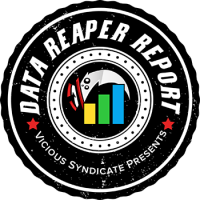
Welcome to the 235th edition of the Data Reaper Report!
Contributing to the Data Reaper project through Hearthstone Deck Tracker or Firestone allows us to perform our analyses and to issue the weekly reports, so we want to wholeheartedly thank our contributors. Without the community’s contributions, there would be no project. Contributing data is very easy, so if you enjoy our content and would like to make sure it remains consistent and free – Sign up!
Quick Links
Class/Archetype Distribution | Class Frequency | Matchup Winrates | vS Power Rankings | vS Meta Score | Class Analysis & Decklists | Meta Breaker of the Week | How to Contribute | Credits
Number of Games
| Overall | 565,000 |
| Top 1K Legend | 23,000 |
| Legend (Excluding Top 1k) | 46,000 |
| Diamond 4 to 1 | 61,000 |
| Diamond 10 to 5 | 78,000 |
| Platinum | 73,000 |
| Bronze/Silver/Gold | 284,000 |
Class/Archetype Distribution
[TABS_PRO id=58145]
Class Frequency
[TABS_PRO id=58146]
Class Frequency Discussion
The introduction of Renathal has changed the format so much that we had to postpone last week’s report as any field we would have presented was completely outdated. Druid is the best example. The class was previously a fringe afterthought and has now become one of the most popular classes in the format at all levels of play. Prestor Druid, a deck that had a brief appearance during Alterac Valley before fading as a meme, has now turned mainstream. Celestial Druid, mostly running Renathal, has also spiked in play. Druid numbers at legend are at 25%. Malfurion is back to being an enemy and Wildheart Guff must be nerfed again, apparently.
Some things don’t change, and that’s Rogue being everywhere. The class makes up well over 10% of the field before jumping to 25%+ of the field at top legend. It’s mostly Thief Rogue (Vessel and Stash), but a few Bomb Rogues can also be seen with a new Smokescreen build.
Quest Priest has attracted a lot of Renathal enthusiasts, with the deck thought to benefit from going 40. Small pockets of Naga and Boar Priest remain, mostly at top legend.
Mage’s popularity remains mostly intact, with Big-Spell Mage making the biggest waves. Mech Mage is more common at lower ranks of ladder, while some Wildfire Mage is also found.
There are no significant changes in Shaman, with it mostly comprised of its two murloc-centric archetypes, and a small presence of Burn Shaman. Not much Renathal activity here.
There is a lot of Renathal activity in Warlock, with the prince taking over the Curse Warlock archetype and lifting its play rate. The class with Life Tap was tipped by many to be one of the best fits for the legendary.
Hunter’s popularity follows a familiar pattern of being quite high outside of legend, while dipping at legend. But what’s happening within the archetypes is quite interesting. Both Big-Beast and Quest Hunter have seen Renathal builds emerge relatively later than other classes and gain traction. Why would we run Renathal in Hunter? That’s a good question.
While it has encouraged some classes, Renathal seems to have scared away others. Demon Hunter’s damage-based win condition seems to have influenced Fel DH’s lower play rate. Holy Paladin and Control Warrior have significantly shrunk in numbers. At top legend, Warrior and Paladin are barely seen, while at lower ranks they’re mostly comprised of Mech Paladin and Quest Warrior.
So which decks are strong in this format, and where is Renathal worth playing? Answers now.
[TABS_PRO id=58147]

[TABS_PRO id=58148]
vS Meta Score
[TABS_PRO id=58149]
vS Power Rankings Discussion
There’s a lot to unpack, and this format is very unrefined, so it’s important to provide context to these numbers.
- Druid
- Prestor Druid is perceived to be a menace on ladder, but the numbers indicate that it is not too powerful. It’s a deck that seems to take advantage of the popularity of some of the underperforming decks in the format. Prestor Druid is strong against passive decks that are incapable of pressuring it effectively to punish its weak early game and absence of any notable defensive tools. We suspect it will decline in play, but perhaps stay ‘overplayed’ much like Ramp Druid was before Onyxia’s lair. It’s a deck that needed Renathal to be competitive, and we explain why in the Druid section.
- Celestial Druid has massively benefitted from the introduction of Renathal, but not necessarily because it started utilizing it. In fact, the addition of Renathal to the deck is matchup-dependent and can be considered a sidegrade move. But, the injection of other Renathal decks has created a favorable field for the archetype to thrive in, especially at legend. Celestial Druid heavily punishes slow, janky decks that lack lethality. But whether it starts with 40 health or not, Celestial Druid is still vulnerable to some of the best decks in the format, including ones that are not purely aggressive.
- Rogue
- Rogue is not the strongest class, but it’s very good. There’s merit to run either Vessel or Stash variants of Thief Rogue, though Vessel is still a bit stronger.
- Bomb Rogue isn’t doing too well, as it might be the deck most hurt by the rise of Renathal decks with its finite damage plan. It’s interesting to note that the new build of Bomb Rogue with Smokescreen exhibits quite the learning curve, and we rate it only behind Boar Priest when it comes to its skill ceiling.
- Priest
- Renathal seems to be a good addition to Quest Priest. The deck has finally become competitive on ladder, with a positive win rate all the way through Diamond. It does dip at legend, with Druid’s popularity becoming a big problem at higher ranks as well as relatively limited player agency. We suspect that this deck will get worse over time and settle for mediocrity.
- Naga Priest looks okay, but very matchup dependent. Its success is riding on Druid’s popularity, and it struggles against many decks that perform extremely well but aren’t too popular yet. A rise in Mage and Shaman could become a problem here.
- Boar Priest is crippled by Celestial Druid. Even at top legend, this deck exhibits a poor win rate. There’s just no way around it when an oppressive matchup becomes this popular. You need to get lucky and just not run into them, and you’d be happy not to run into Demon Hunters and Mages as well.
- Mage
- Big-Spell Mage is one of the best decks in the format. Everywhere on ladder, it’s either the best or the 2nd best performer. It’s just extremely well-rounded and difficult to counter, much like before, but it also handles Renathal matchups very well and beats both Druid decks convincingly. Just very strong.
- Mech Mage is a Tier 1 deck at every rank bracket before falling into Tier 4 at top legend. Very strong choice to climb to legend with, but very weak choice to climb to #1 legend with. We’ve said it before, but it compares to Quest Warrior.
- We estimate that Wildfire Mage’s best and most curated build is a Tier 3 performer. Not terrible, but it’s hard to find a reason to play it over BSM.
- Shaman
- Is Shaman just the strongest class in the game? It’s hard to argue against it, with both Murloc and Murloc-Control Shaman looking very powerful across ladder and making up two of the three best performers at top legend.
- Control Shaman can be hard countered by Quest Priest or Curse Warlock, but that means you’re playing Quest Priest or Curse Warlock. The only other very slight unfavorable that’s popular is Big-Spell Mage. Not too difficult to understand why this deck is good.
- Murloc Shaman’s success is a bit more matchup-dependent. It is absolutely thriving right now because it destroys Druid like no other deck, and it is also the best counter to Big-Spell Mage. There are ways to stop it, but those options aren’t common enough, which is why it’s so good everywhere on ladder.
- Burn Shaman could be quite good as well. We’re seeing some refinement that could propel it to Tier 2. It will struggle to gain traction because the murloc decks are better, but it’s pretty good as well.
- Warlock
- Curse Warlock looks quite weak, and Renathal seems to be a trap that has only made the archetype worse. Loss of the deck’s consistency in finding its win condition has resulted in worsening results in the deck’s performance against other late game strategies, while the benefits have been marginal. Gul’dan wins our “bait of the week” medal. Congratulations.
- Murloc Warlock is similar to Murloc Shaman in that it beats Druid and Big-Spell Mage very convincingly, but it’s just a worse deck overall, which is why it hasn’t gained much popularity.
- Hunter
- I bet you didn’t expect Hunter to be the class that’s utilizing the strongest Renathal decks in the format, but this is a fact!
- Big-Beast Hunter is good. Big-Beast Hunter with Renathal is very good. One of the two best choices to climb to legend with, and a respectably good deck at higher levels of play, is only going to get better as Renathal takes over.
- Quest Hunter’s performance and matchup spread are undergoing a drastic change that this report cannot fully capture. Thanks to Renathal, this archetype is in a midst of a huge spike in its win rate, and it exhibits Tier 1 aspirations. The only potential roadblock here is the popularity of Druid, but should this class decline as we suspect it will to some degree, Quest Hunter could represent the strongest list of 40-cards on ladder. Those who have hailed Renathal as a promoter of “value-centric control decks” before its release must be thrilled with the return of one of the most notorious Stormwind questlines to top tier play.
- Demon Hunter
- Fel DH is doing fine. Demon Hunter players, you should not fear the passive Renathal decks. Fel DH does well against every Renathal deck that sits back and tries to survive. The damage is too much for them to handle most of the time and starting at 40 is not enough. The Renathal decks you should fear come from the Hunter class, because it’s a race and you’re starting 10 meters back.
- Paladin
- Holy Paladin is one deck that’s suffering from the prevalence of weird Renathal decks. The 40-life total makes it harder for the Paladin to finish off the opponent with a buffed Smite, and the never-ending deck is difficult to outlast. The situation should get better for the deck since many of its counters are expected to decline. We can already see its performance peak at top legend, where meta developments are more advanced.
- Mech Paladin is a very strong deck through most of ladder but takes a dumpster dive at top legend along with Mech Mage. Nothing we haven’t seen before. If you want to counter Druid, Murloc Shaman is a superior choice.
- Warrior
- Control Warrior is unplayable. The current field is impossible to deal with for a deck that relies on a pure removal game plan to win and lost its strong cheese potential. Quest Warrior is forgettable. Warrior seems irrelevant.
Class Analysis & Decklists
Demon Hunter | Druid | Hunter | Mage | Paladin | Priest | Rogue | Shaman | Warlock | Warrior
Rogue is in a good position in the meta, though its popularity isn’t just a factor of its strength. As we’ve seen for a while, players tend to flock to Maestra decks.
Vessel Thief Rogue build is looking very solidified, with Okani emerging as the 30th card. Okani is insanely good in the current format, and you’re going to see it included in most decks in the report. There are many decks in the current meta that tend to play one card a turn, and Okani is debilitating against them (Big Spell Mage, Big Beast Hunter and Quest Priest are very good examples). It can also be used to delay Lady Prestor for a turn, which is game winning. It’s just good.
Okani can easily slot into Jackpot Thief Rogue, though there’s also an option to run SI:7 Extortion (Shadowstep is weaker than both). We suspect Okani has the highest upside when used well.
Bomb Rogue has emerged with a new Trickster/Smokescreen build that looks like a clear upgrade on previous iterations of the archetype. Burning Blade Acolyte provide the deck with a stabilizing line up play against aggressive decks, as well as a path to pressure slower opponents through the board. It makes the deck less one-dimensional, and we’ve noticed its skill ceiling metrics have improved after this transformation.
We recommend testing Tooth of Nefarian over SI:7 Extortion for the additional burn option. Extortion isn’t that good in a deck that doesn’t run Maestra/Gnoll.
Druid has been the class most dramatically affected by the introduction of Prince Renathal. Both of its popular archetypes have leaned into the Prince to find success with extra-large decks.
Let’s start with Prestor Druid and understand why Renathal works here. There are three primary reasons.
The first is that Prestor Druid is extremely linear in its early play pattern and lacks defensive tools. The extra health helps you get there on time before you get rolled over by an aggressive opponent. The deck looks to draw Prestor as consistently and early as possible. With Capture Coldtooth Mine and Jerry Rig Carpenter, you will always have Prestor on time, while Innervate and Mailbox Dancer help you cheat it out earlier.
The second reason is most important and might be the least intuitive. A bigger deck means a larger number of threats, and with Wildheart Guff, you’re able to draw two dragons a turn post-Prestor. The higher number of dragons is crucial because it means you’re more likely to generate Kazakusan, which is game changing in late game matchups (we did some complicated math and found that your chance to generate a single Kazakusan in the average game is roughly 65%). Without a higher dragon count, defensive decks would be more likely to run you out of resources. This is partly why Prestor Druid is strong in slow matchups. It turns the drawback of a bigger deck into an upside.
The third reason is simple: The rest of your deck beyond Prestor, Guff and your tutor cards matter very little. When most of your deck doesn’t matter, running 40 cards over 30 cards is less of a penalty since you’re guaranteed to draw the cards that do matter. The minions in your deck possess some synergy with your game plan, but none of them are crucial. They are all expendable pieces to transform into dragons.
Celestial Druid’s success is a bit more straight-forward. The current meta is so slow and clunky with decks like Curse Warlock and Quest Priest that its general game plan is good regardless of whether it runs Renathal or not. The decision to include Renathal is entirely based on whether the extra health cushion is worth the significant drawback, so it is matchup dependent. Therefore, we’re featuring both a 30-card and 40-card decklist.
Key findings for the builds: Neptulon is so good that it’s worth including in the 30-card list. Okani is core in both builds. Manasaber and Panther are interchangeable. Primordial Drake and Amalgam are interchangeable. Arcanist and Starfish are flex cards only worth considering in the Renathal build. It’s hard to find space for them in the perfect 30.
Tired of Renathal Druids? You could try the ramping Vanndar Druid. While not amazing, this build is surprisingly competitive, and we estimate is around Tier 2/3.
Quest Priest is another good home for Renathal, and the reasons are easy to understand since it is very similar to Prestor Druid, but less extreme.
First, its win condition is always drawn on turn 1, it gets discovery draw effects along its quest phases, while Purified Shard can also be easily tutored, so its game plan is not hindered as much by its decreasing draw consistency.
Second, its play pattern is clumsy and inflexible, making it likely to be outpaced by a more efficient opponent, so having extra health means it can more easily bridge into its stabilizing plays on turn 6-8. It has some removal but it’s still weak defensively.
Third, the cards in the deck don’t matter as much as their cost. Quest Priest doesn’t rely much on power spikes, so it’s happy to play any card if it helps progress its quest. This negates the drawback of having a bigger and weaker deck on average since “the cards don’t matter”.
The featured build is a tweak on Meati’s #1 legend list. We’ve cut some spells to increase early game consistency. We also added Okani because it’s Broke-ani. We like the single copy of Amulet of Undying. It’s an alternative wincon that works well with Spirit Guide. Finley is very good in this deck. It helps you reset bad draws and can be used to dodge Mutanus or find Purified Shard in some unique situations.
Don’t take this list as gospel though. There are many cards you can put in this deck and not see widely varying results. A Highlander Reno version of Quest Priest isn’t even that much worse. That should tell you all you need to know.
There are no big changes in Naga & Boar Priest. Just run Okani in Naga Priest. That’s about it.
Big-Spell Mage does not seem very eager to run Renathal, which isn’t surprising considering it’s very reliant on finding its power spikes to win games.
Two cards we’re interested to see more data on are Mordresh and Brann. Both have promising preliminary results, and they can be easily inserted into the deck by dropping the second copies of Spammy Arcanist and Smothering Starfish (silence isn’t as good in this meta). Brann works well with many cards in the deck, so it’s not overly situational, while Mordresh gives you a big closer. These cards also shine in slower matchups, and the format has obviously gotten slower thanks to Renathal.
Wildfire Mage doesn’t compare to BSM. It’s a significantly worse deck, but we’re featuring it because of its increasing visibility. There isn’t much variety when it comes to its build.
Mech Mage is one of the strongest decks in the format, up until top legend where it’s hilariously unplayable. We’ve noticed Peasant getting significantly stronger post-Renathal. There is a growth in decks that can’t answer a turn 1 Peasant very consistently, and a decline in ones that do (Demon Hunter).
Shaman is arguably the strongest class in the format. Control Shaman is the best deck at higher levels of play, where the decline of Quest Priest and Curse Warlock makes it even better. This deck seems to struggle against other late game opponents, and there’s a novel card choice that seems to help there: Bloodlust!
Furthermore, we’ve noticed that Brann and School Teachers have gotten better since the meta slowed down so much. We’ll see if that changes, and we end up favoring Windchills again down the road. Glugg can be slotted in place of Command of Neptulon, which is a very matchup-dependent card that gets a little better with Bloodlust.
No changes in Murloc Shaman. The current format is encouraging you to run two Bloodlusts.
Burn Shaman has looked better and could be Tier 2 post-refinement. Schooling is good. Brann/Teachers are making a comeback here as well. Command of Neptulon is much stronger in this deck compared to Control Shaman.
Curse Warlock has proven to be a poor fit for Renathal, contrary to the initial thought that the class with Life Tap would appreciate the extra health. The problem is that Warlock lacks the characteristics that make Renathal successful. It doesn’t have strong tutors to its win condition, so its game plan gets much slower and less consistent with extra cards. Its removal and life gain packages are already strong, so it’s not desperate for a cushion of health because it’s already defensively sound. Adding cards only dilutes its defensive shell. There are exceptions, such as pure burn decks like Bomb Rogue, but those matchups just aren’t common.
Based on our estimates, running a 30-card build of Curse Warlock should be better, and we’re featuring a curated list with some flex/tech options. There’s a choice between the value of School Teacher and the standalone impact of Demonic Assault. Then you can sprinkle some tech cards to replace Mortal Coils, if you’re desperate for them (in this format, you shouldn’t be).
We’re still featuring a 40-card build in case you insist on making your deck worse, or if you’re wondering how we would build it in case it made more sense down the road.
The bottom line though, whether it’s 30 or 40 cards, Curse Warlock isn’t great.
We’re not sure anyone thought that the strongest utilizer of Renathal would be the Hunter class, but this is where we are. We already have a sense of what makes Renathal a positive component to a deck, so let’s look at the two archetypes that utilize it here.
Big-Beast Hunter doesn’t have a ‘clear’ win condition, but it has a lot of tutor effects in Tracking, Selective Breeder and Pet Collector. It’s also a deck with very weak defensive tools. If it gets pressured, it can only realistically start stabilizing past turn 5. Finally, its ability to close out games against defensive opponents is heavily determined by its ability to keep churning out threats, which makes the bigger deck less of a downside. Wing Commander Ichman is one card that becomes more powerful with a list of 40-cards, for example.
The featured list was made by Sidisi and is superior to the 30-card iterations of the archetype we’ve featured before. Battle Ram is very strong in this list, and you’re not desperate for Azsharan Saber to pull beasts from your deck since you have more time with the extra health to play Ram-discounted beasts from your hand.
The most questionable card in the deck is Devouring Swarm. It’s very weak, but we haven’t found something better in this week’s database. There should very likely be something better, so those are two slots the deck can find upgrades on. A second Azsharan Saber is one option. A Naga package is another option, but it requires a bigger overhaul. We’re curious about Savannah Highmane because of this deck’s thirst for threats. It’s a suggestion without any empirical basis.
Quest Hunter exhibits Tier 1 potential with a Renathal build. The prince seems to have good synergy in quest decks, since their win condition is always drawn in their opening hand, but the major upside of Renathal in Quest Hunter isn’t as clear cut as it is in other decks.
We’ve studied the archetype’s database of games and came to understand why Renathal builds are so much better than non-Renathal builds.
Quest Hunter has good removal options and uses damage-dealing spells to clear an opponent’s minions. It is not comparable to Druid decks’ lack of early game answers. However, those Hunter spells double up as pure face damage or face damage enablers post-quest completion. What the extra 10 health does is open a bigger time window for the Quest Hunter to ignore their opponent’s board and direct all their resources to the opponent’s face. Quest Hunter becomes less interactive, and less likely to expend damage resources (spells and refreshing hero powers) on survival. This “going face efficiency” makes up for the deck building drawback inefficiency.
The build we’ve iterated turned out to be very close to what Habugabu ended up on, but we suggest dropping Urchin Spines for Conch’s Call. More draw and increased consistency at activating Ancient Krakenbane could be nice. Do not keep Conch’s Call in the mull, though.
The life of the Demon Hunter has been uneventful within the Renathal craze.
Fel DH is a decent deck that doesn’t really fear a life total of 40. There is a greater focus on late game longevity with players cutting Bone Glaive for Need for Greed, while the early game snowballing of Battleworn Vanguard has become less important, so Herald of Chaos has become more popular to activate Predation. Nothing else is happening.
Players have experimented with Renathal in Holy Paladin, but the card doesn’t seem like a great fit so far. This is where the disparity between pre-release expectation and post-release reality is very cleanly shown. Control decks that are defensively sound have no interest in Renathal, since they are already well equipped to outlast their opponents, and the price of drawing their best cards less often just extends the time they need to spend surviving and make them worse when that “extra protection” is redundant.
As a result, we recommend no changes to the Holy Paladin build. This deck is struggling to beat Renathal decks but running its own Renathal only makes things worse.
Mech Paladin hasn’t changed much either. Motherships are currently valued because of the slower meta, but we can see them becoming a liability again at some point.
Warrior’s situation is not pretty. Quest Warrior is looking decent at most ladder brackets thanks to a very passive meta that allows it to complete its quest without too much trouble, but its limited ceiling at higher levels of play is well known. What’s funny is that the meta is so slow that Nellie suddenly looks like a playable card again.
Then we have Control Warrior, which has been crippled by the changes in the format. No shot of doing much when Druid is this popular, but Control Warrior even loses to bad Renathal decks. We’ve featured a build for the archetype but we’re not responsible for any ranks lost.
Big-Spell Mage is the strongest and most well-rounded deck on ladder based on its great performance across all rank brackets. It’s hard to go wrong with it. It’s just good.
But if you’re thirsty for a Renathal deck, Quest Hunter might offer you the best one. Turns out that Renathal has synergy with Questlines and having more life means you can ignore your opponent attempting to play Hearthstone and shoot them in the face harder. Much degeneracy.
Preparing our weekly article requires a significant amount of time and effort from many individuals. We would like to wholeheartedly thank our current Patreons, whose generous donations help us fund computing and server costs.
vS Gold is our membership plan aimed to support our efforts towards improving our content and data analysis while receiving some bonuses and extra features.
Tier 3+ Patrons
Special thanks to Leo G, Aaron B, Jed M, Drew M, Alan J, Zolstar, Sean H, Steve F, Andrew N, Alonso P, James Y, Je-ho, Stephen H, William H, 1RiceBowl1, Alex S, PeejTreon, Josh G, Matthew H, Bruno B, Amir, Matthew P, amenbrotep, Karhu, Fisherington, Christopher N, Eric F, Eric L, BraveLittleStove, Lime, Kaushal, David, Joshua B, Jeff C, Pi, Reharl, Scott L, Mark P, Keith C, The Big Dawg, nburst, Alex S, Jess M, Peter, Lepton, Bob L, Charlah R, Chocobo, Tim B, Chad K, Alex W, John Q, Ashton F, Ethan G, for supporting us this month.
Contributors
Here are all the people that participated in bringing you this edition of the vS Data Reaper Report:





















